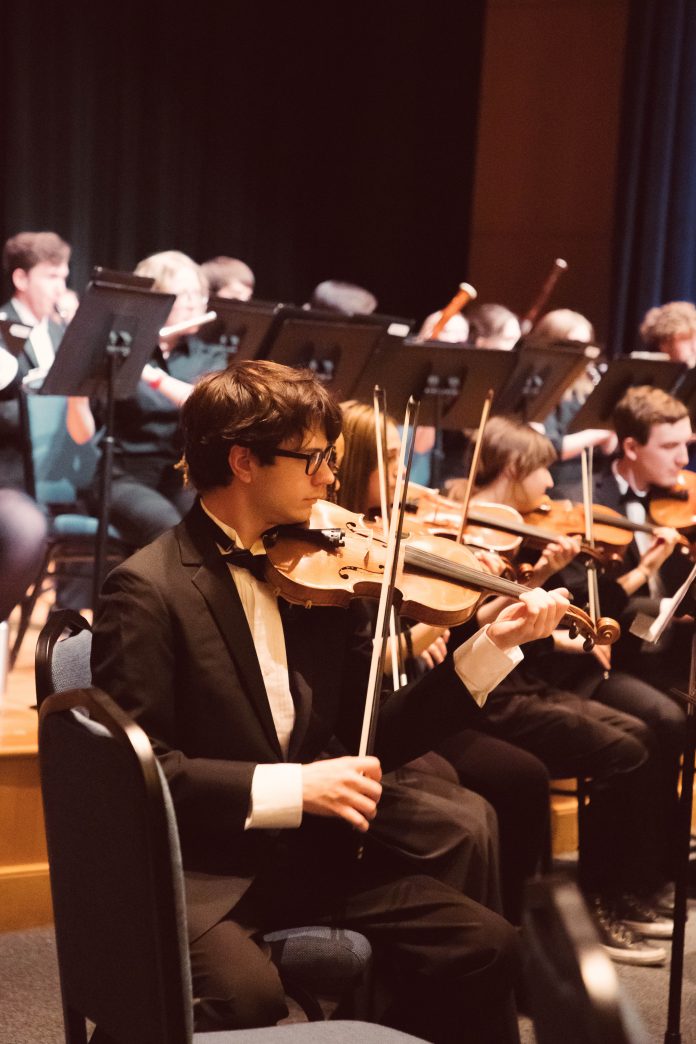Thursday, March 9, the Sadler Center’s Commonwealth Auditorium swelled with the sound of woodwinds, brass and strings. Murmurs from the crowd surrendered to melodies made by enchanting cellos, trilling trumpets and trembling trombones. By the fall of the first crescendo, it was clear to every ear that the College of William and Mary’s Symphony Orchestra had commenced its annually anticipated winter concert.
The third concert of the academic school year, this performance followed the fall concert, which took place on Dec. 10, 2022. However, the winter concert is far from the last as this concert precedes a joint concert with the Virginia Chamber Orchestra at Capital One Hall in Tysons Corner Center on March 25 as well as a trip to Vienna and Prague scheduled for late May. Amidst these events, audience member Thu Luong ’26 described the importance of the winter concert as a source of publicity for the organization.
“I think it’s very important that they get recognition,” Luong said. “I knew we had an orchestra, but I didn’t know about it, and if you don’t know about things, you tend not to care about it. I think it’s lovely that they’re getting exposure like that.”
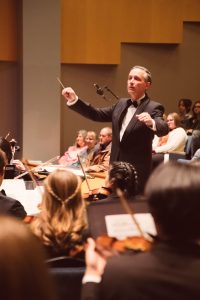
The $10 general admission ticket prices, in addition to the $100 reduction in individual travel costs funded by a recent Tribe Funding campaign, help WMSO musicians afford travel essentials for the trip to Europe. Additionally, WMSO Publicity Director and second chair bassoonist Meghan Kirk ’24 noted that the winter concert allowed the group to practice a live rendition of the program itself, including all four movements of the Symphony in G minor by Edouard Lalo, making excellent practice for future outings.
“Honestly, I always just kind of go in with a mindset of doing better than I did last concert because that’s just the easiest way of keeping myself improving,” Kirk said. “Since we’re playing that Lalo piece, maybe I’ll be like, ‘Oh man, I really need to practice that part more before we go play it in Europe.’”
The concert involved solos selected and performed by winners of a concerto competition back in November 2022. Associate professor and Director of Orchestras David Grandis emphasized that these solos were another point of significance for the event.
“It’s a great concert because they’re going to be able to perform one movement of a concerto with the orchestra,” Grandis said. “That gives them exposure in the soloist situation.”
Third chair french hornist Lydia Doughty ’24 played her solo during the Morceau de Concert Op. 94 by Charles-Camille Saint-Saëns, and WMSO Co-Social Chair and fourth chair violinist Sarah Russell-Hunter ’23 played her solo during the Scène de Ballet Op. 100 by Charles Auguste de Bériot.
Doughty noted that she chose to perform Morceau de Concert Op. 94 because she took a special liking to it ever since she heard it on a Spotify playlist for best horn solos before the pandemic in 2020. She started playing it even before COVID-19 hit, and she has been practicing it with her instructor ever since.
“Working on it with my teacher, I got into the nuance of every single part and how every single note needed to be played horizontally,” Doughty said. “There are all these different things that you don’t think about with orchestral music that you need to think about with a solo.”
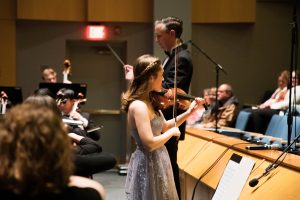
Russell-Hunter played after the Pavane Pour Une Infante Défunte by Maurice Ravel. She learned her Bériot piece for the first time during fall 2020 over Zoom lessons, and she said she decided to refine it throughout the summer of 2022 because the song inspired her to continue with music during quarantine. She spoke about how performing the solo was nothing short of an ethereal experience.
“I honestly blacked out a little during it,” Russell-Hunter said. “It almost feels like floating on air to know a piece so well and to have people play so well behind me — I will never experience anything like it again in my life, I don’t think.”
Grandis described his favorite part of an orchestra performance to be whenever his ensemble is able to get lost in the music they find themselves playing — much like how Russell-Hunter did during her solo. He noted that while it is not a common occurrence, that singular sensation is what makes the whole experience so special.
“We play the notes every day, we play the same notes, we play the same rhythm, but something is happening during the performance sometimes,” Grandis said. “That sublimates all of these things that we’ve learned for weeks since the beginning of the semester. We feel comfortable enough to let yourself go, and open your heart to the music, and something special is happening. And it doesn’t necessarily happen all the time. We try. You can’t make it artificial.”
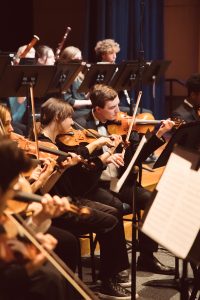
Co-Tour Director and third chair viola Ben Neifeld ’25 also found himself getting lost in the performance. Neifield has been a part of WMSO since his first semester in his freshman year, but he has had experience with the instrument since he was in the fourth grade. Inspired by his sister to take it up, he said he has stuck with the viola for the way its timbre fits into the greater orchestral sound. He said that sound had a particularly soul-stirring quality during the last performance of the winter concert.
“I kind of lost myself a little in the first and second movements of the Lalo,” Neifeld said. “I was feeling some feelings. I really got into it.”
However, detached from the music itself, one obstacle that emerged in regards to this event was the gas leak reported at One Tribe Place at 1:05 p.m. earlier the same day. Many musicians had to evacuate their dorms, leaving essentials such as sheet music, instruments and performance attire without prior notice. Neifeld said occurrences like these have convinced him of the importance of developing future contingency plans.
“Earlier today, there was the gas leak at OTP,” Neifeld said. “Exec was kind of having a little crisis about how some people have their instruments there, some people have their concert attire, music. So I was kind of dealing with that.”
Another challenge was the difficulty posed by Commonwealth Auditorium’s stage design as its inability to accommodate the entire orchestra placed the winds on the stage but the strings on the carpeted area in front of the stage. The resulting height difference between the two sections was greater than the traditionally recommended dimensions for the orchestral pit and risers, which Grandis noted regrettably compromised the room’s acoustics.
“It’s completely disproportionate,” Grandis said. “For the balance of the orchestra, it’s very tough.”
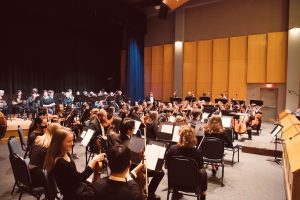
Arrangements for the Winter Concert began directly after the fall concert in the form of group practices every Tuesday and Thursday from 4:00 p.m. to 6:00 p.m. However, the College recognizes WMSO’s time commitment by offering members one institutional credit through a course that can satisfy the Arts Proficiency credit after two semesters, meaning that members will be able to devote more time to the rehearsals.
Grandis further emphasized the significance of practicing as a collective, given that his main advice to his musicians would be to learn to have a good group sound. He said that while it’s much easier to tell if bandmates are listening to each other in smaller pop, rock or jazz groups, the bigger, more complicated composition of a symphony orchestra means it is important to put in the extra effort to be sensitive to one another’s activities.
“With an orchestra, it’s so huge, that some people don’t necessarily always listen to each other,” Grandis said. “They rely too much on the conductor. So they can be sometimes a little bit out of sync because they are not aware enough about all of the things that are happening around them. So you have to treat this like chamber music, like a little group of pop or jazz. You have to listen to each other, be really connected.”
In addition to collective rehearsals, though, Kirk said individual-level study was another component of the preparatory process.
“Some people have a lot of time to practice and will just go down to the little Ewell practice rooms and hang out there and practice,” Kirk said. “I love seeing people when they post on social media, on Snapchat stories, when they just play on their violin in the practice rooms. It’s very fun.”

Ultimately, Grandis defined success for the winter concert as its ability to bring not just the audience, but the musicians and himself joy. He said these three tiers of accomplishment work together to make for a fruitful recital.
“There are very different ways to define success,” Grandis said. “If people are happy, it’s already a success. That’s maybe the easier success, because people are not necessarily as demanding. Then there’s the second level of success, if [the musicians] are happy about what they did. And then it will be if I am happy about it. I am very often very happy about it.”
In regard to the first tier, Luong said she was deeply moved by the music. She came to the Winter Concert to support her friend and fourth chair cello Kevin Sae-Tung ’26, and she said she left with a feeling of satisfaction incomparable to other modern music.
“I think it’s remarkable how it’s just noise, it’s just a sound, and how that sound can keep me compelled and entertained for an hour and thirty minutes,” Luong said. “I can’t just sit and listen to music on YouTube and be like ‘This is fulfilling,’ but this was fulfilling.”

With regards to the second tier of accomplishment, Russell-Hunter said she noticed a distinctive quality among her fellow musicians. She said she enjoyed herself, and she could tell her sentiment was shared by her bandmates.
“It’s about having fun, getting into the spirit of the music, really letting that shine through with our personalities,” Russell-Hunter said. “When I look around the orchestra, I can see each individual person bringing their own sense of musicianship into what they do even though you never really hear people individually.”
Neifeld said the intellectual and academic diversity inherent within the event reflects the cross-disciplinary culture found at the College. Students from a wide range of on- and off-campus student organizations, co-curricular commitments, identity groups and extracurricular activities were represented in both the audience and the ensemble, which Neifeld said he appreciated.
“So many people from so many organizations that we know in different contexts all came to show support for us,” Neifeld said. “That’s totally representative of everything else I do here. Everyone supports everyone else in their endeavors.”
Luong also recognized the concert as an extension of what it means to be a student of the College. She found that her participation not only demonstrates the College’s active campus life, but also holistic of the institution and its values as a whole.
“I really appreciate having the arts in my life — having some form of culture,” Luong said. “Every time there’s some sort of live music, I will be there. I’m a sucker for live music. I guess that’s a William and Mary thing.”

